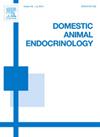前列腺素F2a对牛黄体和黄体化颗粒细胞趋化因子mRNA的差异反应和信号通路
IF 2.1
2区 农林科学
Q2 AGRICULTURE, DAIRY & ANIMAL SCIENCE
引用次数: 0
摘要
免疫细胞在黄体溶解过程中的调节先前已被描述过,但是在牛黄体(CL)中介导PGF2α诱导免疫细胞的细胞间和细胞内途径尚未明确定义。Real-time PCR检测趋化因子mRNA, Western blotting检测PGF2α处理早期和中期CL及相似期黄体化颗粒细胞(LuGC)后信号蛋白磷酸化水平。在第11天(具有溶血能力),PGF2α在治疗后1小时诱导CXCL8、CXCL2、CCL2和CCL8的表达,并在治疗后10小时继续刺激这四种趋化因子。在第4天(没有溶血能力),趋化因子mRNA在PGF2α后1小时的增加不那么强劲,在PGF2α后10小时没有可检测到的影响。在黄体化颗粒细胞(LuGC)中,PGF2α诱导CXCL8和CXCL2 mRNA显著增加,而CCL2和CCL8 mRNA无变化。在不诱导黄体化的条件下,在颗粒细胞中孵育相同时间,PGF2α不改变任何这些趋化因子的转录。在成熟的LuGC中,PGF2α处理可以快速磷酸化NFκB通路中的关键蛋白NFKBIA和MAP激酶通路中的关键蛋白MAPK3,但这些蛋白的总量没有变化。此外,在LuGC中,PGF2α对CXCL2的诱导被PKC抑制剂和NFκB通路抑制剂抑制。此外,pgf2 α-调节的NFKBIA磷酸化被PKC抑制剂阻断。相比之下,PGF2α对CXCL8的诱导被MAP激酶抑制剂抑制。因此,PGF2α诱导趋化因子与溶血能力密切相关。此外,两个关键的趋化因子CXCL8和CXCL2似乎通过PGF2α激活的不同信号通路起源于大黄体细胞。本文章由计算机程序翻译,如有差异,请以英文原文为准。
Differential responsiveness and signaling pathways for prostaglandin F2a on chemokine mRNA in bovine corpus luteum and luteinized granulosa cells
Regulation of immune cells during luteolysis has been previously described, however inter- and intra-cellular pathways that mediate PGF2α induction of immune cells in the bovine corpus luteum (CL) have not been clearly defined. Real-time PCR was used to measure chemokine mRNA and Western blotting used to measure phosphorylation of signaling proteins after PGF2α treatment of early and mid-cycle CL and in similar-stage luteinized granulosa cells (LuGC). In Day 11 CL (with luteolytic capacity), PGF2α induced expression of CXCL8, CXCL2, CCL2, and CCL8 at 1 h after treatment and continued to stimulate the four chemokines at 10 h after treatment. In Day 4 CL (without luteolytic capacity), there was a less robust increase in chemokine mRNA at 1 h after PGF2α with no detectable effect at 10 h after PGF2α. In luteinized granulosa cells (LuGC), PGF2α induced a dramatic increase in mRNA for CXCL8 and CXCL2 with no change in mRNA for CCL2 and CCL8. In granulosa cells incubated for a similar time in conditions that did not induce luteinization, PGF2α did not alter transcription of any of these chemokines. In mature LuGC, treatment with PGF2α rapidly phosphorylated a key protein in the NFκB pathway, NFKBIA, and in the MAP kinase pathway, MAPK3, with no change in total amounts of these proteins. Moreover, in LuGC, induction by PGF2α of CXCL2 was inhibited by a PKC inhibitor and a NFκB pathway inhibitor. In addition, PGF2α-regulated phosphorylation of NFKBIA was blocked by the PKC inhibitor. In contrast, induction of CXCL8 by PGF2α was inhibited by a MAP kinase inhibitor. Thus, PGF2α induction of chemokines is closely related to luteolytic capacity. Further, two key chemokines, CXCL8 and CXCL2, seem to originate from large luteal cells through distinct signaling pathways that are activated by PGF2α.
求助全文
通过发布文献求助,成功后即可免费获取论文全文。
去求助
来源期刊

Domestic animal endocrinology
农林科学-奶制品与动物科学
CiteScore
5.50
自引率
4.80%
发文量
58
审稿时长
31 days
期刊介绍:
Domestic Animal Endocrinology publishes scientific papers dealing with the study of the endocrine physiology of domestic animal species. Those manuscripts utilizing other species as models for clinical or production problems associated with domestic animals are also welcome.
Topics covered include:
Classical and reproductive endocrinology-
Clinical and applied endocrinology-
Regulation of hormone secretion-
Hormone action-
Molecular biology-
Cytokines-
Growth factors
 求助内容:
求助内容: 应助结果提醒方式:
应助结果提醒方式:


